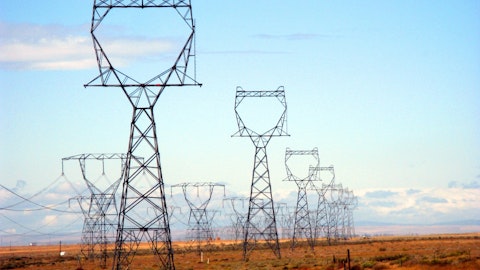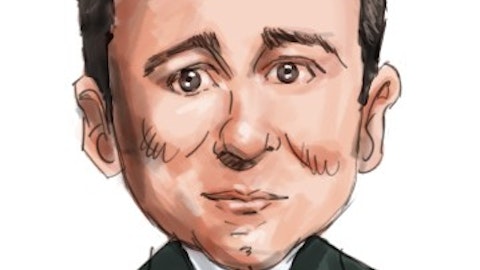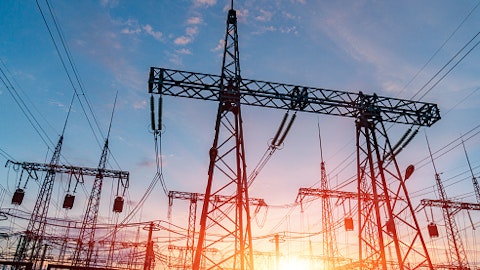FirstEnergy Corp. (NYSE:FE) Q4 2022 Earnings Call Transcript February 14, 2023
Operator: Greetings, and welcome to the FirstEnergy Corp. Fourth Quarter and Full Year 2022 Earnings Conference Call. At this time, all participants are in a listen-only mode. A brief question-and-answer session will follow the formal presentation. As a reminder, this conference is being recorded. I would now like to turn the call over to Irene Prezelj, Vice President, Investor Relations and Communications for FirstEnergy Corp. Thank you. Ms. Irene Prezelj, you may begin.
Irene Prezelj: Thank you. Welcome to our fourth quarter and full year 2022 earnings call. Today, we will make various forward-looking statements regarding revenues, earnings, performance, strategies, prospects and other matters. These statements are based on current expectations and are subject to risks and uncertainties. Factors that could cause actual results to differ materially from those indicated by these statements can be found on the Investors section of our website under the Earnings Information link and in our SEC filings. We will also discuss certain non-GAAP financial measures. Reconciliations between non-GAAP financial measures, the presentation that supports today’s discussion and other detailed information about the quarter and year, can be found in the strategic and financial highlights document on the Investors section of our website.
We’ll begin today’s call with presentations from John Somerhalder, our Board Chair and Interim President and Chief Executive Officer; and Jon Taylor, our Senior Vice President and Chief Financial Officer. Several other executives will be available for the Q&A session. Now I’ll turn the call over to John Somerhalder.
John Somerhalder: Thanks, Irene. Good morning, everyone. Thanks for joining us. We had a strong year in 2022, and we are excited to make even more progress on our goals in 2023. Our full year 2022 GAAP earnings are $0.71 per share and operating earnings are $2.41 per share, which is slightly above the midpoint of our guidance range. Before I get started today, I would like to take a minute to say thank you to all of our employees for their efforts over the past year. I’m proud of what they’ve accomplished and company we have become. Our progress this past year is due to the efforts of our 12,000 employees who are serving our customers and working to make this company better for the long term. Thank you. With that, we have a lot of ground to cover today, so let’s get started.
Two years ago, we were taking some of the first steps to transform FirstEnergy. In 2022, we hit full stride, stretching ourselves to strengthen and enhance nearly every aspect of our organization. The scope and pace of these changes have been remarkable. Just to touch on a few of the highlights. First, we made significant improvements in our financial position. This includes deploying proceeds from the $1 billion common equity issuance that closed in late 2021, together with the $2.4 billion to 19.9% interest sale in FirstEnergy Transmission LLC that closed midyear to reduce debt by nearly $3 billion in 2022, most of which was at APICORP. As a result, we lowered holding company debt as a percentage of total debt to 24% from 33% at the end of 2021.
On the operational front, we transitioned to a new five-state operating model and engaged in more than 175 projects across the Company to modernize the way we work and deliver a superior customer experience as part of our FE Forward program. At the same time, we continue to enrich our culture with an unwavering commitment to our core values. As a result of this work, we’re entering 2023 as a more innovative, efficient and forward-thinking organization where employees are sharing ideas and working to move the Company forward. This year, we intend to build on our momentum. We’re working to be a premier electric company with a strong foundation and a customer center focus that is enabling the clean energy transition. Earlier this month, we announced an agreement to sell an additional 30% interest in FirstEnergy Transmission LLC to Brookfield’s Super-Core Infrastructure Partners for $3.5 billion.
This transaction, which is expected to close in early 2024, supports our plans to improve our balance sheet and for approximately $1 billion of incremental capital investments, which we believe will drive long-term value for all our stakeholders. And as John will discuss, our regulatory calendar will address the critical investments that support reliability and smarter and cleaner electric grid. We are introducing 2023 guidance of $2.44 to $2.64 per share. The midpoint of this range represents a 6% growth from our original 2022 midpoint of $2.40 per share, and it offsets the pension impacts we discussed last year. We are also introducing first quarter 2023 guidance of $0.56 to $0.66 per share. In addition, we are affirming our targeted 6% to 8% annual operating earnings growth rate, which represents year-over-year growth based off of the prior year guidance midpoint.
I’d like to spend a moment to provide an update on the CEO search process, and I realize there is much interest in this important topic. Late last year, we shared the broad criteria that we were looking for a strong track record of executive leadership within the utility industry, have demonstrated ability to execute on the regulatory front, leading operational and financial discipline and impeccable credibility with external stakeholders. And we always anticipated a three- to six-month time line. I can share that interest has been strong. The process has been quite active since the beginning of the year and discussions among the Board and select candidates continue. The Board is committed to selecting the right individual to lead our talented team, and we trust you will respect the process through its conclusion.
We look forward to sharing the announcement when the Board completes its work. In the meantime, we continue to execute on the strategy we have in place. The Board and the management team are fully committed to this path and the expectation is that the new CEO, once name, will be as well. It’s an exciting time for FirstEnergy as we’re poised to leverage our many strengths from our diverse assets to the transformation that has taken place since 2020 to the talented employees who are making the Company stronger with their drive, passion and ingenuity. I appreciate your continued support. We are concentrating our efforts on long-term stability and success as a leading utility. We will continue to navigate our path with the same determined focus you’ve seen over the last few years.
Now, I’ll turn the call over to Jon Taylor.
Jon Taylor: Thanks, John, and good morning, everyone. Thank you for joining us. I joined John in thanking our employees for their incredible work this past year. Their perseverance and commitment made it possible for us to navigate challenging conditions and make important progress on our goals. We have a busy year ahead of us as we continue driving towards our aspirations and laying additional groundwork for our future success. I’ll start my remarks with a review of our top regulatory and business priorities. Then we’ll move to a discussion of 2022 financial results and 2023 expectations. We have an active regulatory calendar this year. Later this quarter, we’ll file for new distribution rates in New Jersey and Maryland and file an application to consolidate our Pennsylvania legal entities.
Then by midyear, we plan to file a rate case in West Virginia, an electric security plan in Ohio in an infrastructure investment program, or IIP in New Jersey. Broadly speaking, the rate cases will address the significant customer-focused investments we’ve made since our last rate cases in each of the states and provide an opportunity to bring our distribution equity returns in line with the industry average allowed returns. At the end of 2022, our weighted average ROE was 7.7% and while authorized ROEs ranged from 9.6% to 10.5%. Our current residential rates are 10% to 40% below our peers in the states we serve and we are sensitive to the pressures of the current inflationary environment on our customers. Our rate cases this year will ensure we maintain our affordability position while enhancing the customer experience, provide further support for low-income customers and support the critical investments for a more reliable, resilient and smarter electric grid.
Each filing will address unique elements to better serve customers in that state. For example, the Maryland and New Jersey rate cases will highlight our plans to improve distribution reliability through incremental investments. In Maryland, we plan to file concurrently with the rate case for continuation of the electric distribution investment surcharge. And in New Jersey, our rate case will highlight our plan to file an infrastructure investment program by the middle of this year. These programs will focus on investments such as circuit resiliency and reliability, feeder sectionalization and distribution automation and substation upgrades. In West Virginia, the rate case will reflect our recently filed proposal with the commission to update depreciation rates associated with Mon Power’s II coal-fired generation assets, which based on the depreciation study, would have retirement dates of 2035 and 2040.
Any increase in depreciation rates would not take effect until conclusion of the upcoming base rate case. Turning to consolidation of our four Pennsylvania utilities, this is an important step to align with our new state operating model, simplify our legal entity structure and increase the flexibility and efficiency of our financing strategy. This consolidation won’t represent any changes in current electric rates for our Pennsylvania customers. Those will be combined as appropriate over time through future rate case activity. In Ohio, our ESP V will adjust generation procurement for non-shopping customers after the current ESP expires in May of next year. In addition, this filing will address other regulatory programs and mechanisms such as continuation of existing capital writers such as the DCR and AI.
And as we extend our commitment to have a broad stakeholder dialogue, we are considering programs that support energy efficiency, low income and additional customer-related initiatives. We also look forward to advancing the $626 million Ohio grid mod Phase 2 capital investment plan, which was filed last July. If approved by the commission, grid mod will continue our work to enhance the delivery of safe, reliable power, offer modern customer experiences and support emerging technologies. As we make each major regulatory filing, we’ll post a convenient and comprehensive summary to our IR website. You’ll find this information on the Investor Materials page of the site and a new section named regulatory corner. Turning to financial matters. Our recent agreement with Brookfield represents an excited milestone in our progress to be a premier utility with a strong financial position and sustainable long-term growth.
The $3.5 billion transaction will deliver highly attractive, efficient equity financing. The transaction is structured with a $1.75 billion due at closing and aligned with our investment and financing plans an 18-month $1.75 billion note at 5.75% interest. Once the transaction closes, we intend to deploy the proceeds to further improve our credit metrics and our balance sheet targeting FFO to debt metrics of 14% to 15%. The proceeds also supported more than 10% increase in our 2024 and 2025 capital investment plans. We’re using nearly $1 billion into the CapEx plan, brining our target to approximately $18 billion over the 2021 to ’25 period. Through this plan, we’re targeting 75% formula rate investments and more than 7% average annual rate base growth beginning in 2024.
We will use NOLs and existing tax credits to offset most of the taxable gain on the transaction, resulting in an expected cash taxes of approximately $50 million. Beginning in 2023 and moving forward, we expect to be a federal cash taxpayer at approximately $200 million annually. Our agreement to sell an additional 30% interest in FET triggered a deferred gain on the prior 19.9% sale that was completed in 2022. We As a result, we recognized a $752 million non-cash charge in our fourth quarter ’22 GAAP results. Operating earnings were $0.50 per share for the fourth quarter of 2022 and on an adjusted basis, excluding unique drivers this year, which include the impact of accounting changes, rate credits provided to Ohio customers and equity financing transactions.
Fourth quarter operating earnings increased $0.09 per share or 22% compared to the same period in 2021. In our distribution business, fourth quarter results benefited from weather-related demand, along with the impact of our capital investment programs. These results nearly offset higher operating expenses, primarily associated with accelerating certain planned maintenance work, incremental reliability activities and higher material and storm costs. Total distribution deliveries increased 2%, resulting from weather that was closer to historic norms compared to the very mild fourth quarter of 2021 and increased demand from industrial customers. Residential sales increased 3% from the fourth quarter of 2021, but decreased slightly on a weather-adjusted basis.
Consistent with our observations on the October call, sales to residential customers remain about 3% higher than pre-pandemic levels. In the commercial sector, fourth quarter deliveries were up slightly from the prior year due to weather and decreased almost 2% on a weather-adjusted basis. While sales to commercial customers increased slightly overall in 2022, they continue to lag 2019 levels by more than 4%. Finally, sales to industrial customers increased nearly 2% compared to the fourth quarter of 2021, led by continued recovery in the automotive, mining, fabricated metals and steel sectors. Overall, industrial sales are trending closer to pre-pandemic levels with full year 2022 sales less than 1% below 2019 and fourth quarter 2022 sales flat to 2019 levels.
In our transmission business, fourth quarter results benefited from continued formula rate base growth of 9% year-over-year associated with our Energizing the Future investment program as well as lower financing costs. I want to take a quick second to recognize our transmission, supply chain and materials operations teams, who overcame significant supply chain and other issues in 2022, investing nearly $1.4 billion in projects to improve grid reliability and resiliency. For example, we successfully completed the first segment of a 64-mile transmission line rebuild that will enhance service reliability for customers in Eastern Ohio. And in Central New Jersey, construction is only on two projects that will upgrade 19 miles of transmission lines and benefit 50,000 customers.
In 2023, our transmission investment plan is $1.7 billion, and we have a long project pipeline ahead of us in this premium business. And finally, our corporate segment benefited from higher investment earnings from the Signal Peak mining operation and lower financing costs associated with the holding company debt redemptions earlier this year. For the full year, we reported GAAP earnings of $0.71 per share, largely reflecting the non-cash tax charge I mentioned earlier. Full year 2022 operating earnings were $2.41 per share, slightly above the midpoint of our guidance. Again, on an adjusted basis, excluding the accounting changes, Ohio rate credits and equity transactions, we achieved a $0.26 improvement in operating earnings compared to 2021, which represents 12% year-over-year growth.
Our solid financial performance resulted in $2.7 billion in cash from operations last year, which is in line with our expectations, and we made more than $3.2 billion in customer-focused regulated investments and plan to execute our 2023 capital investment plan of $3.4 billion. And we met our 2022 FFO to debt target, executed our financing plan and achieved investment-grade credit ratings with Fitch and just recently received a positive outlook from S&P. The materials posted to our website yesterday afternoon contain an updated financial outlook through 2025, including our capital plan, load forecast and financing plan. It’s our expectation that we will extend our outlook beyond 2025 later this year. As John mentioned, our 2023 earnings guidance of $2.44 to $2.64 per share reflects overcoming the enormous challenge we face related to the pension, which year-over-year was a $0.38 impact to our 2023 plan.
The combination of accelerating O&M into 2022 together with lower interest expense resulting from debt reductions and earnings from Signal support our projection for 6% growth year-over-year at the guidance midpoint. Our focus is executing on our plan to drive strong regulated earnings growth, resulting in our long-term 6% to 8% growth outlook, anchored by increasing transmission and distribution utility investments. While pension and the positive offset provided in the near term by Signal Peak have complicated our earnings story, we are laser-focused as a management team to improve the earnings quality over time by replacing earnings from the Signal Peak and pension with high-quality core T&D earnings growth and the significant benefits associated with improving our balance sheet.
In terms of other 2023 drivers, our expectation is for the continued strong growth from the investments we’re making for our 6 million customers in our distribution and transmission businesses and an improvement in our cost structure, driven in part by the work we accelerated into 2022, but this is certainly an area we will need to keep an eye on with respect to inflationary pressures. And ending on another positive note, we are fresh off a recent Board meeting, where we discuss the importance of the dividend to our investors. The Board approved a new dividend policy that raises our targeted payout ratio to 60% to 70% up from 55% to 65% previously. And we also expect to resume dividend growth subject to Board approval for dividends payable late this year.
Our new payout ratio is more in line with our peers, and reflects the steps we’ve taken to improve our credit profile and our commitment to enhancing value for investors. And as I mentioned on Friday, S&P moved First Energy to a positive outlook based on the announcement of the asset sale and our strategy to use those proceeds in a credit supportive manner. We’re pleased with this action, which recognize our work to deliver on our commitments. I’m excited about our plans for this year and for the future. We’ve taken significant steps over the past few years in a broad range of areas to move the Company forward from the cultural changes, the improvement of our financial and credit profile and the execution on our regulatory strategy focused on benefiting our customers.
We feel like we have great momentum for the future focused on delivering value for our customers, shareholders and all of our stakeholders. As always, thank you for your time and your interest in FirstEnergy. Before we take your questions, I’m going to turn the call back over to John.
John Somerhalder: Thanks, John. We’ll have plenty of time for your questions, but I wanted to take another opportunity to say how pleased I am with FirstEnergy’s progress. As you’ve heard this morning, this team has delivered on our goals. They have diligently executed our plan, and they have exemplified our commitment to performance excellence. I’m proud of where we are as a company, and I’m excited about our future. Now, let’s open to Q&A.
See also 15 Most Profitable Dividend Stocks and 13 Stocks Big Short Michael Burry is Buying and Selling.
Q&A Session
Follow Firstenergy Corp (NYSE:FE)
Follow Firstenergy Corp (NYSE:FE)
Operator: Thank you. We’ll now be conducting a question-and-answer session. Our first question comes from the line of Nick Campanella with Credit Suisse. Please proceed with your question.
Nick Campanella: Appreciate all the disclosures, a lot in the deck here. So I guess, John, on the CEO time line, can you just help us understand what the expectation is on the time line now? Should you have someone announced before the second quarter call? Can you kind of help narrow that down for us a little bit more?
John Somerhalder: Yes. Thanks Nick. Consistent with what we’ve talked about earlier, which is not only the criteria, what we’re looking for, and we talked about that as part of the prepared remarks, the time line that we talked about three to six months. Everything we’re viewing now is still consistent with that. I can tell you that we’ve had quite a bit of activity related to the Board search process so far this year. It’s been very active and that continues as we speak right now. I think a couple of positives are that because we’ve continued to execute as a company, we see good progress, and that’s what we indicated that even though we were going through the CEO search process that we continue to execute on things like the FET transactions, that’s been a very positive.
Also, the Board has been very focused on getting the right individual. But saying that, we do realize that we want to address this issue, the Board has a high priority right now and is very active on concluding the search.
Nick Campanella: Okay. All right. And then, I guess, you guys have done a good job like offsetting the pension headwind with the Signal Peak earnings, which do see material and just acknowledging your prepared remarks, those are probably more cyclical type earnings. So just as we think about the fact that you’re going to extend the plan in the coming later part of this year, and the fact that maybe by ’25, the Signal Peak earnings may not be there, just — what are the offsets that kind of keep you within that annual 6% to 8% growth trajectory that you can kind of share with us if you’ve identified anything?
Jon Taylor: Nick, this is John Taylor. So let me maybe take a few minutes to kind of explain how we’re thinking about the long term. So if you think about 2023 ex pension and ex-Signal Peak, there’s going to be obviously significant improvement in the earnings year-over-year of the business, mainly because of the actions that we took last year to accelerate maintenance expenses and the plans that we put in place for additional cost controls this year. The interest expense benefits from improving the balance sheet as the holding company as well as continued growth in our transmission business. And those items more than offset the decline in Signal Peak and pension that was close to 30% of our earnings in 2022. And now for this year is projected to be about 15% of our earnings in 2023.
So, if I think about the plan going forward, I think what you’ll see is above-average growth from the business ex-pension, ex-Signal Peak from new base rates and formula program capital spend in our distribution companies, the continued organic growth from our transmission business and then how we’re going to deploy the proceeds in an EPS accretive way from the FET transaction. And so our current plan, pension Signal Peak is going to be less of a contribution in those outer years, representing probably around 10% of the total earnings of the Company. So obviously, what’s going to be important for us is regulatory outcomes, cost control is going to be very important. And that, along with our transmission business continuing to drive significant year-over-year earnings will drive the overall growth of the Company.
Operator: Thank you. Our next question comes from the line of Andy Storozynski with Seaport Global. Please proceed with your question.
Andy Storozynski: So just wanted to ask about the CEO search. So John, I think you mentioned that there’s an expectation from the Board that the new appointee is going to stick with the current strategy. So does that mean that we shouldn’t expect any changes to your EPS growth target, at least 25% by the new CEO?
John Somerhalder: Yes. I mean we view our strategy as very straightforward. What we’re going to focus on related to investment in the business, controlling our cost, executing on that strategy, the management team very strongly supports that strategy. The Board very strongly supports that strategy. So yes, we’re looking for a CEO that would be very much in line and be able to execute on that strategy.
Andy Storozynski: Okay. And then the other, John, the — I’m just wondering if you have any expectations for the ESP and then the distribution case in Ohio, given the backdrop in the state and then ongoing investigations related to HP 6? I mean, — is — how do you think about the potential earnings impacts related to those two proceedings?
Jon Taylor: Yes. I guess from my perspective, there’s a difference between the ESP and a base rate case, right? So the ESP is primarily focused on the procurement of generation services for those customers that don’t shop. Having said that, there are some rider programs in the ESP that we will ask to continue on such as our distribution capital recovery rider and so those are important to us. But in the main, that’s not nearly as significant as a base distribution case. I would tell you in our plan, we’re not planning for anything extraordinary. We’re going to file an ESP that’s consistent with our peer companies in the state. And that’s kind of how we plan for the future.
Andy Storozynski: Okay. And lastly, I mean, if I understand correctly, you are growing the dividend, maybe as soon as the midyear, maybe a little bit later. So when you talk about the FFO to debt targets, those already account for the fact that the dividend will start growing.
Jon Taylor: Yes, that’s all in our plan. Yes, Andy, that’s correct.
Operator: Thank you. Our next question comes from the line of Steve Fleishman with Wolfe Research. Please proceed with your question.
Steve Fleishman: Yes, hi. Thank you. So just to follow up with a prior question. So when you kind of summarize the earnings outlook, is it fair to say then that the utility earnings and the parent should be growing better than the 6% to 8%, essentially while the
Jon Taylor: Yes. Go ahead, Steve. Finish up.
Steve Fleishman: Yes. Now the other part shrinks. Is it — and then what — is that just because you’re going to — you’ve got the rate base growth and you’ll be able to, I guess, improve you exceed this under-earning situation improve over the next few years?
Jon Taylor: Right, right. So I mean, if you just look at the cases that we’ll file next year, New — or excuse me, this year, New Jersey, West Virginia, Maryland, all of them, except for Maryland, have fairly low return on equity. So New Jersey 7%, West Virginia, 6.6%, we’re also filing for capital programs in the distribution business with the grid mod program in Ohio, we’re going to file for an IIP in New Jersey. So, all of that will provide significant growth to the distribution business. You know about the transmission company and the robustness of that business and then how we deploy the proceeds into the balance sheet from the FET transaction will reduce otherwise incurred interest expense. And so as we look at the business ex-pension, ex-Signal Peak, you’ll see above-average growth.
Steve Fleishman: Okay. And then I guess a question or John Somerhalder. Just on the CEO search, are you still looking for the same characteristics that you mentioned from the beginning? And I guess, the other question is it takes longer. Is there any chance you’re also reviewing like strategic options separately as part of this, too?
John Somerhalder: Yes. The requirements, what we’re looking for, Steve, are very consistent with what we’ve talked about. We have not changed that. As we’ve said, we’ve had good interest from individuals that have that. What I can tell you, consistent with what we’ve said earlier is, the Board truly supports and believes in the plan, and we are really focused on finding the right CEO that can execute on that plan. So, that is the path that the Board is headed down.
Operator: Thank you. Our next question comes from the line of Shahriar Pourreza with Guggenheim Securities. Please proceed with your question.
James Ward: It’s James Ward on for Shar. How are you?
John Somerhalder: Hi, James. How you doing?
James Ward: Hi, doing well. Thank you for taking my question. We’re glad to see in the slides that the 6% to 8% annual growth rate target continued beyond 2025, the recently announced FET transaction obviously gives you a lot of flexibility in terms of deploying capital, as you mentioned, either towards rate base growth or debt repayment, both of which yield recurring benefits to earnings. But specifically on the investment side, you’ve highlighted the step-up in annual rate base growth from 6% to 7% in ’24 and ’25, is 7% just 24% and 25% expectation or like the 6% to 8% annual EPS target continuing post 2025, should we be assuming that 7% rate base growth also applies annually post ’25? Just trying to make sure we’re thinking correctly about the drivers of earnings in that period, even though you’re not officially guiding beyond ’25 in terms of a capital plan at this point in time? Just high level.
Jon Taylor: Yes, James. So I think from my perspective, the CapEx plan is increasing from $3.3 billion last year to over $4 billion by the time we get out to 2025. And quite frankly, I see that trend continuing into the back half of the decade. So post 2025, obviously, we’ll provide you much more in the way of details once we announce a longer-term plan. But I do see the need for significant capital investments post 2025 to really support resiliency, reliability to support the electrification of different industries, continuation of our transmission CapEx program. So I do see that level and more increasing through the back half of the decade.
Operator: Thank you. Our next question comes from the line of David Arcaro with Morgan Stanley. Please proceed with your question.
David Arcaro: I was wondering if you could speak to the Pleasants plant in West Virginia, just the considerations there around potentially acquiring that plant and how it could factor into the resource planning outlook in the state?






